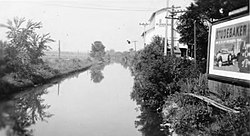Illinois-Michigan Canal
|
Illinois and Michigan Canal Locks and Towpath
|
|

a scene at Seneca, Illinois
|
|
| Nearest city | Joliet, Illinois |
|---|---|
| Coordinates | 41°34′11″N 88°4′11″W / 41.56972°N 88.06972°WCoordinates: 41°34′11″N 88°4′11″W / 41.56972°N 88.06972°W |
| Area | 1,130 acres (4.6 km2) |
| Built | 1848 |
| NRHP Reference # | 66000332 |
| Significant dates | |
| Added to NRHP | October 15, 1966 |
| Designated NHL | January 29, 1964 |
The Illinois and Michigan Canal connected the Great Lakes to the Mississippi River and the Gulf of Mexico. It ran 96 miles (154 km) from the Chicago River in Bridgeport, Chicago to the Illinois River at LaSalle-Peru. The canal crossed the Chicago Portage and helped establish Chicago as the transportation hub of the United States, before the railroad era. It was opened in 1848, its function was largely replaced by the wider and shorter Chicago Sanitary and Ship Canal in 1900 and it ceased transportation operations with the completion of the Illinois Waterway in 1933.
Illinois and Michigan Canal Locks and Towpath, a collection of eight engineering structures and segments of the canal between Lockport and LaSalle-Peru, was designated a National Historic Landmark in 1964.
Portions of the canal have been filled in. Much of the former canal, near the Heritage Corridor transit line, has been preserved as part of the Illinois and Michigan Canal National Heritage Corridor.
Canals were the highways of the day. The Illinois and Michigan Canal connected the Mississippi Basin to the Great Lakes Basin. The canal influenced Illinois's north border. The Erie Canal and the Illinois and Michigan Canal cemented cultural and trade ties to the Northeast rather than the South. Prior to the canal, farming in the region was limited to subsistence farming. The canal made agriculture in northern Illinois profitable, opening up connections to eastern markets. With the expansion of agriculture, the canal created the city of Chicago. Without the initial stimulus of the canal, Chicago would not have attracted the populations, railroads and the industry that it did.
...
Wikipedia


